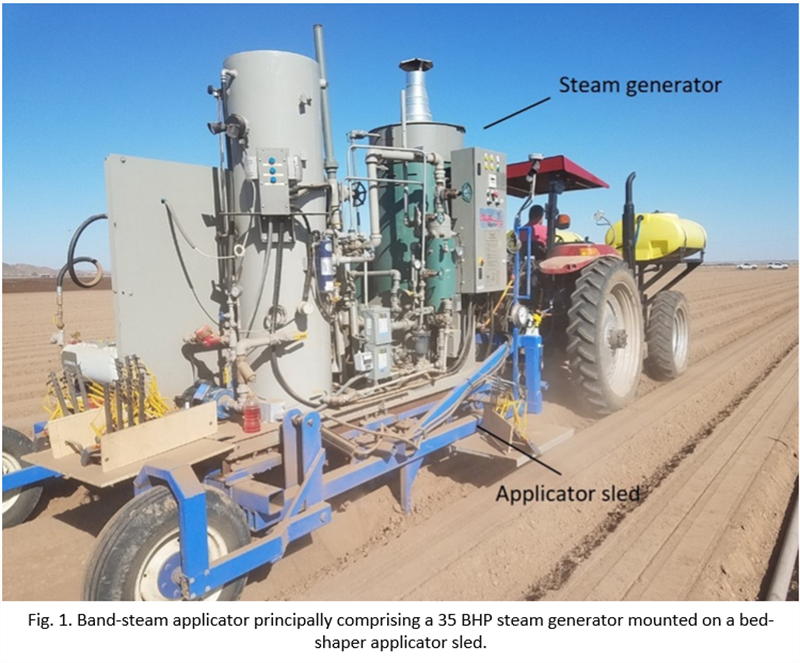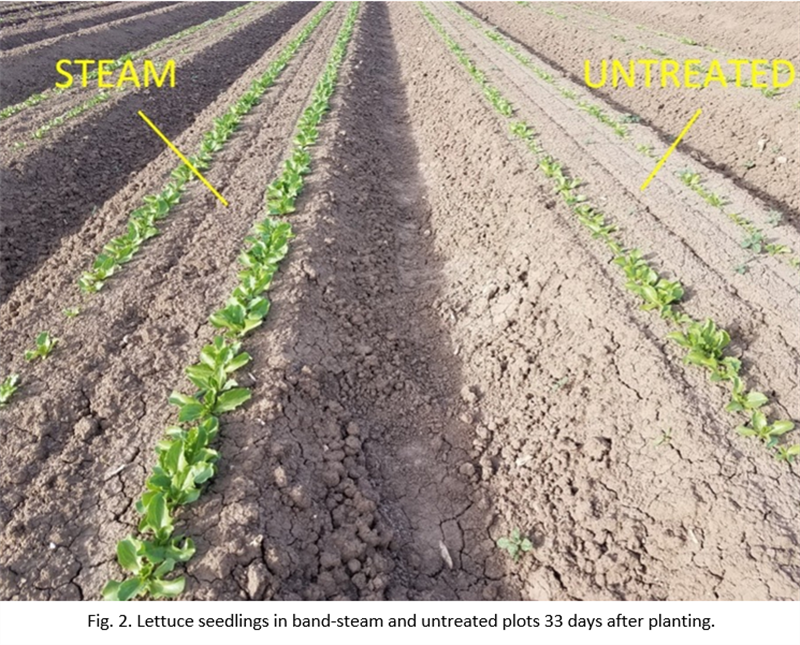In previous articles (Vol. 11 (13), Vol. 11 (20), Vol. 11(24)), I’ve discussed using band-steam to control plant diseases and weeds. Band-steaming is where steam is used to heat narrow strips of soil to temperature levels sufficient to kill soilborne pathogens and weed seed (>140 °F for > 20 minutes). The concept is showing good promise. This past season, three trials were conducted examining the efficacy of using steam for disease and weed control in Yuma, AZ. In the studies, steam was applied in a 4-inch-wide by 2-inch-deep band of soil centered on the seedline using a prototype band-steam applicator (Fig.1). The band-steam applicator is principally comprised of a 35 BHP steam generator mounted on top of an elongated bed shaper. The apparatus applies steam via shank injection and from cone shaped ports on top of the bed shaper.
Trial results were very encouraging as the prototype applicator was able to raise soil temperatures to target levels (140°F for >20 minutes) at viable travels speeds of 0.75 mph. Steam provided better than 80% weed control and significantly lowered hand weeding time by more than 2 hours per acre (Table 1). Results also showed that Fusarium colony forming units (CFU) were reduced from 2,600 in the control to 155 in the 0.75 mph and 53 in the 0.5 mph treatments, respectively (a more than 15-fold reduction). A significant difference in Fusarium wilt of lettuce disease incidence was not found, however disease infection at the field site was low (< 2%) and differences were not expected. At 0.5 mph, fuel costs were calculated to be $238/acre which was considered reasonable and consistent with the values reported by Fennimore et al. (2014).

An unexpected finding was that plants in steam treated plots appeared to be healthier and more vigorous than untreated plots (Fig. 2). This trial is still in progress and it will be interesting to see if this improved early growth translates into increases in crop yield.
In summary, early trial results are showing good promise for use of band-steam as a non-herbicidal method of pest control. We plan on conducting further trials in this multi-year study. If you are interested in evaluating the device on your farm and being part of the study please contact me. We are particularly interested in fields with a known history of Fusarium wilt of lettuce and/or Sclerotinia lettuce drop that will be planted to iceberg or romaine lettuce.
As always, if you are interested in seeing the machine operate or would like more information, please feel free to contact me.
Acknowledgements
This work is supported by Crop Protection and Pest Management grant no. 2017-70006-27273/project accession no. 1014065 from the USDA National Institute of Food and Agriculture, the Arizona Specialty Crop Block Grant Program and the Arizona Iceberg Lettuce Research Council. We greatly appreciate their support. Any opinions, findings, conclusions, or recommendations expressed in this publication are those of the author(s) and do not necessarily reflect the view of the U.S. Department of Agriculture.
A special thank you is extended to Mellon Farms for allowing us to conduct this research on their farm.
References
Fennimore, S.A., Martin, F.N., Miller, T.C., Broome, J.C., Dorn, N. and Greene, I. 2014. Evaluation of a mobile steam applicator for soil disinfestation in California strawberry. HortScience 49(12):1542-1549.


Click link below or picture to see the band-steam and co-product applicator in action!





